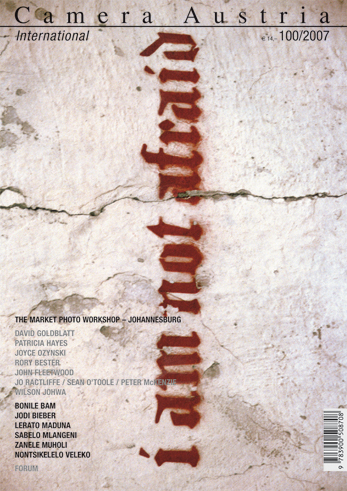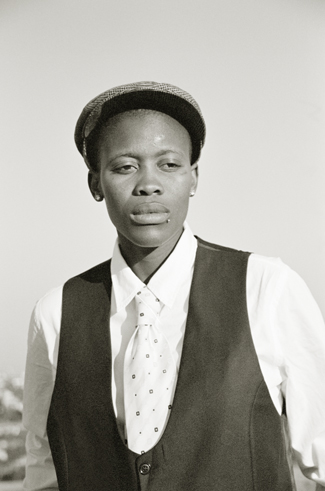Camera Austria International
100 | 2007
- CHRISTINE FRISINGHELLI, WALTER SEIDL
To the project "I am not afraid" - DAVID GOLDBLATT
Dear Christine - JOYCE OZYNSKI
Market Photo Workshop - PATRICIA HAYES
Visual Emergency? Fusion and Fragmentation in South African Photography of the 1980s - WILSON JOHWA
THE BACK AND FORTH PROJECT - RORY BESTER
From the Market Photo Workshop - BONILE BAM
Initiation of the Mind - JODI BIEBER
David
- ZANELE MUHOLI
Faces & Phases - SABELO MLANGENI
Invisible Women - LERATO MADUNA
Diski 9/9 - Us and the Ball - NONTSIKELELO VELEKO
- WILSON JOHWA
Mpilonhle Mpilonde (Good Life, Long Life) - NONTSIKELELO VELEKO
The Ikageng Women's Outreach Project - JO RACTLIFFE, PETER MCKENZIE, SEAN O'TOOLE
Pre-post: A Trajectory in South African Photography - JOHN FLEETWOOD
Market Photo Workshop. Strategies towards Photography Training

Preface
In our anniversary issue Camera Austria No. 100 we intentionally want to refrain from looking back on our own history, and decided to look to the future instead. We dedicate this issue – that accompanies the exhibition of the same name – to the Market Photo Workshop founded by David Goldblatt in Johannesburg at the end of the 1980s. This issue thus picks up one of our magazine’s main programmatic threads: to reflect on the social usages of photography, directly to support artistic production, and to offer a platform particularly fort he youngest movements in contemporary photography and media art.
In an interview with Camera Austria in 2001, Pierre Bourdieu commented on the field of cultural production, describing it as an “inverted world of economy”. The more specialised the respective cultural fields, he maintained, the less they are amenable to commercialisation, quite the contrary: A fixation on specific contents guarantees the respective cultural fields more autonomy – an autonomy that is, however, latently threatened by Neoliberalism with its striving for thorough commercialisation of all areas of society.
In the year of Camera Austria ‘s foundation – 1980 – the publishers and editors of this magazine set out to strengthen an as yet (at least in European art context) marginalised sphere in what is already a small field of contemporary artistic production by launching Camera Austria, a magazine devoted primarily to contemporary photography. The autonomy of our work is due in large part to the fact that our project was able to develop in the protective, yet artistically challenging framework of Forum Stadtpark, but also in view of the special status of photography in the field of art.
Read more →Camera Austria International 100 | 2007
Preface
In our anniversary issue Camera Austria No. 100 we intentionally want to refrain from looking back on our own history, and decided to look to the future instead. We dedicate this issue – that accompanies the exhibition of the same name – to the Market Photo Workshop founded by David Goldblatt in Johannesburg at the end of the 1980s. This issue thus picks up one of our magazine’s main programmatic threads: to reflect on the social usages of photography, directly to support artistic production, and to offer a platform particularly fort he youngest movements in contemporary photography and media art.
In an interview with Camera Austria in 2001, Pierre Bourdieu commented on the field of cultural production, describing it as an “inverted world of economy”. The more specialised the respective cultural fields, he maintained, the less they are amenable to commercialisation, quite the contrary: A fixation on specific contents guarantees the respective cultural fields more autonomy – an autonomy that is, however, latently threatened by Neoliberalism with its striving for thorough commercialisation of all areas of society.
In the year of Camera Austria ‘s foundation – 1980 – the publishers and editors of this magazine set out to strengthen an as yet (at least in European art context) marginalised sphere in what is already a small field of contemporary artistic production by launchingCamera Austria , a magazine devoted primarily to contemporary photography. The autonomy of our work is due in large part to the fact that our project was able to develop in the protective, yet artistically challenging framework of Forum Stadtpark, but also in view of the special status of photography in the field of art.
It is with gratitude and joy, but also astonishment, that we are now, upon publication of our 100th issue, looking back on almost thirty years of uninterrupted work, and we can confirm that we have succeeded in professionalising a project and to a great extent, we feel, withstanding commercial constraints. Both in Austria and internationally, Camera Austriahas found a position and has become an important forum within the debates on contemporary photographic practise. Together with our exhibition policy and the “Symposia on Photography”, that are of such decisive importance with regard to the theoretical entrenchment of our work, this has also helped establish the city of Graz as an important point in the system of co-ordinates underlying contemporary artistic photography, ensuring that the artistic and theoretical debate on photography in the context of contemporary art is carried on at a very high level particularly at this specific location in Austria.
The fact that we have succeeded in performing this work successfully and for such a long period, however, is not due to the special focus of this work or our insistence on the subject matter alone, but equally to the support that so many people have lent to our ambitious project: first and foremost artists, to whom the Camera Austria project was dedicated from the outset and to whom it remains dedicated. With their work they define the focal points of the various issues and, in addition, also play a key role in the appearance of the magazine thanks to the design of their contributions. Our thanks are due also to our authors.
Safeguarding the autonomy of our cultural field is also substantially indebted to cultural policy in Austria, in Styria Province, and in the city of Graz. Recent events in the Austrian cultural landscape have shown how unexpectedly and quickly outstanding institutions supported solely by the business world and private individuals can begin to crumble, or, the other way round: how badly the credibility of (also public) institutions can suffer when success is measured by visitor statistics alone, and that those in charge have to prefer projects that lend themselves to commercialisation. Camera Austria , too, was not exempt from hostility, having to assert itself again and again in the face of changing political conditions and fighting to gain free reign. We are grateful and happy to have found many friends and allies who rate autonomy in the field of cultural production very highly in their political understanding. Our magazine and exhibition project, that is devoted uncompromisingly to artistic work and its social significance and that targets an international, highly discriminating audience, would not be feasible without such support. One testimony to this is the >>Camera Austria Award of the City of Graz for Contemporary Photography<<, that has been awarded since 1989 and that will be presented this year to the young Georgian artist Marika Asatiani at the presentation of our 100th issue; the award is a clear token of recognition of our work for the public. Another testimony is our move to Kunsthaus Graz in 2003, that not only led to installation of a public study library but also, in addition to publishing the magazine, allowed us to organise exhibitions on a larger scale and with a greater level of continuity than previously. We would like to express our thanks for that.
The fact that this project has evolved so far is also thanks to the many collaborators who have helped to uphold the Camera Austria project in the past years. Often under the typical, but nevertheless vast workload for this kind of project, they handled day-to-day editorial tasks, curatorial and exhibition-related matters with great commitment and technical expertise. On behalf of them all, we would like to make particular mention of Seiichi Furuya, Reinhard Braun, and Wilfried Prantner whose longstanding collaboration has played a key role in forming our project. In this connection, however, we also remember Elisabeth Printschitz and Jörg Schlick, who unfortunately both died so early, and who left their mark on the profile of our work thanks to their friendship, artistic collaboration and editorial meticulousness.
In order to visualise our latest projects in the context of our editorial and curatorial decisions since 1980, and particularly in order to offer our more recent readers an insight into the artistic and theoretical debates, we are also taking this opportunity to publish an index of Camera Austria issues No. 1 – 100 in addition to the current issue, from Nobuyoshi Araki to Heimo Zobernig, from Diane Arbus to Jeff Wall: in the 100 issues since 1980, we have presented more than 3000 Austrian and international artists, some 800 authors have carried on the critical discourse on contemporary photo art in our magazine, focusing their gaze on current artistic approaches that examine the dispositifs of photography and new image technologies, their modes of effect and patterns of reception against the backdrop of overall cultural conditions and developments. The cultural field has grown larger and interest in artistic photography has increased significantly in recent years. The Camera Austria 1 – 100 index has thus become a reference book providing information on the development of international photo culture and the themes and concerns of almost three decades of contemporary art production.
We would like to take this opportunity to thank our subscribers, readers and advertisers for their maintained interest in our project: Thanks to your commitment you are the real upholders of this so demanding, rather unmarketable and uncommercialisable product that is Camera Austria magazine.
Christine Frisinghelli
Maren Lübbke-Tidow
Manfred Willmann
November 2007
Entries
Forum
SANTU MOFOKENG
ROBIN A. FORTUNE
LEBOHANG MASHILOANE
INGRID MASONDO
MUSA NXUMALO
VATHISWA RUSELO
SAMANTHA SIMONS
SYDELLE SMITH
KUTLWANO MOAGI
MOSHE SEKETE
Imprint
Herausgeber, Verleger und für den Inhalt verantwortlich: Manfred Willmann. Eigentümer: Verein CAMERA AUSTRIA, Labor für Fotografie und Theorie
Alle: Lendkai 1, A-8020 Graz
Redaktion Graz: Christine Frisinghelli, Walter Seidl, Sabine Spilles, Rebekka Reuter
Redaktion Berlin: Maren Lübbke-Tidow
Lektorat: Marie Röbl
Übersetzungen: Wilfried Prantner, Richard Watts, Aileen Derieg



















